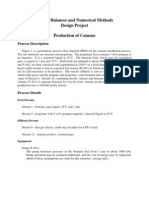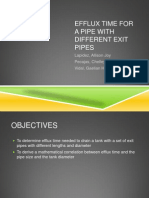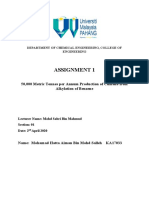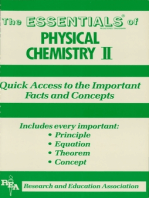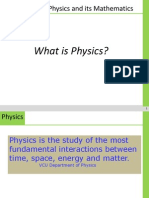0 ratings0% found this document useful (0 votes)
445 viewsChep 424 2014 - 2015 Quiz 2
Chep 424 2014 - 2015 Quiz 2
Uploaded by
Michelle MendozaThe document contains 5 chemical reaction engineering problems involving calculations of rates, conversions, and pressures for various reaction types under different conditions.
Copyright:
© All Rights Reserved
Available Formats
Download as DOCX, PDF, TXT or read online from Scribd
Chep 424 2014 - 2015 Quiz 2
Chep 424 2014 - 2015 Quiz 2
Uploaded by
Michelle Mendoza0 ratings0% found this document useful (0 votes)
445 views1 pageThe document contains 5 chemical reaction engineering problems involving calculations of rates, conversions, and pressures for various reaction types under different conditions.
Original Description:
li
Original Title
CHEP-424-2014_2015-QUIZ-2
Copyright
© © All Rights Reserved
Available Formats
DOCX, PDF, TXT or read online from Scribd
Share this document
Did you find this document useful?
Is this content inappropriate?
The document contains 5 chemical reaction engineering problems involving calculations of rates, conversions, and pressures for various reaction types under different conditions.
Copyright:
© All Rights Reserved
Available Formats
Download as DOCX, PDF, TXT or read online from Scribd
Download as docx, pdf, or txt
0 ratings0% found this document useful (0 votes)
445 views1 pageChep 424 2014 - 2015 Quiz 2
Chep 424 2014 - 2015 Quiz 2
Uploaded by
Michelle MendozaThe document contains 5 chemical reaction engineering problems involving calculations of rates, conversions, and pressures for various reaction types under different conditions.
Copyright:
© All Rights Reserved
Available Formats
Download as DOCX, PDF, TXT or read online from Scribd
Download as docx, pdf, or txt
You are on page 1of 1
TECHNOLOGICAL INSTITUTE OF THE PHILIPPINES
CHEP 424 CHEMICAL REACTION ENGINEERING
STUDENT NAME: _____________________________ SECTION : CH42FB1
INSTRUCTOR : ENGR. LORRAINE A. CARRILLO DATE: July 15, 2010
Solve the following problems . Show detailed solutions.
1. For a zero-order reaction, with stoichiometry A→rR taking place in a constant-pressure set-up, V= 1.5 at t=1 and V=1 at t=0. For the
same reaction, same feed composition and in a constant-volume bomb Π = 1 when t=0, find Π when t=1.
2. The first-order reversible liquid reaction D↔S CDe = 1 M and CSe=0.5M takes place in a batch reactor. After 18 minutes,
conversion of D is 33.33% while equilibrium conversion is 66.7%. Find the rate equation for this reaction.
3. Given the zero-order homogeneous gas-phase reaction A →2.7R, in a constant volume bomb starting with 80% A and 20% inert,
we have
Time 0 1
Total Pressure, atm 1 1.5
If we introduce A at a total pressure of 10 atm, no inerts, what will be the total pressure at t=1? If we introduce A at a partial pressure
of 1 atm and inerts at 9 atm, what will be the total pressure at t=1?
4. The irreversible reaction 2A B takes place in the gas phase in a constant temperature reactor. Reactant A and diluent gas are
fed in equimolar ratio, and the conversion of A is 85 percent. If the molar feed rate of A is doubled, what is the conversion of A
assuming the feed rate of diluent is unchanged?
5. A batch reactor is used to convert a liquid reactant A. the reactant follows second order kinetics. The time in hours required to
convert 60% of A if the initial concentration of A is 0.8 gmol/L and k = 4 L/gmol.h)
TECHNOLOGICAL INSTITUTE OF THE PHILIPPINES
CHEP 424 CHEMICAL REACTION ENGINEERING
STUDENT NAME: _____________________________ SECTION : CH42FB1
INSTRUCTOR : ENGR. LORRAINE A. CARRILLO DATE: July 15, 2010
Solve the following problems . Show detailed solutions.
1. For a zero-order reaction, with stoichiometry A→rR taking place in a constant-pressure set-up, V= 1.5 at t=1 and V=1 at t=0. For the
same reaction, same feed composition and in a constant-volume bomb Π = 1 when t=0, find Π when t=1.
2. The first-order reversible liquid reaction D↔S CDe = 1 M and CSe=0.5M takes place in a batch reactor. After 18 minutes,
conversion of D is 33.33% while equilibrium conversion is 66.7%. Find the rate equation for this reaction.
3. Given the zero-order homogeneous gas-phase reaction A →2.7R, in a constant volume bomb starting with 80% A and 20% inert,
we have
Time 0 1
Total Pressure, atm 1 1.5
If we introduce A at a total pressure of 10 atm, no inerts, what will be the total pressure at t=1? If we introduce A at a partial pressure
of 1 atm and inerts at 9 atm, what will be the total pressure at t=1?
4. The irreversible reaction 2A B takes place in the gas phase in a constant temperature reactor. Reactant A and diluent gas are
fed in equimolar ratio, and the conversion of A is 85 percent. If the molar feed rate of A is doubled, what is the conversion of A
assuming the feed rate of diluent is unchanged?
5. A batch reactor is used to convert a liquid reactant A. the reactant follows second order kinetics. The time in hours required to
convert 60% of A if the initial concentration of A is 0.8 gmol/L and k = 4 L/gmol.h)
TECHNOLOGICAL INSTITUTE OF THE PHILIPPINES
CHEP 424 CHEMICAL REACTION ENGINEERING
STUDENT NAME: _____________________________ SECTION : CH42FB1
INSTRUCTOR : ENGR. LORRAINE A. CARRILLO DATE: July 15, 2010
Solve the following problems . Show detailed solutions.
1. For a zero-order reaction, with stoichiometry A→rR taking place in a constant-pressure set-up, V= 1.5 at t=1 and V=1 at t=0. For the
same reaction, same feed composition and in a constant-volume bomb Π = 1 when t=0, find Π when t=1.
2. The first-order reversible liquid reaction D↔S CDe = 1 M and CSe=0.5M takes place in a batch reactor. After 18 minutes,
conversion of D is 33.33% while equilibrium conversion is 66.7%. Find the rate equation for this reaction.
3. Given the zero-order homogeneous gas-phase reaction A →2.7R, in a constant volume bomb starting with 80% A and 20% inert,
we have
Time 0 1
Total Pressure, atm 1 1.5
If we introduce A at a total pressure of 10 atm, no inerts, what will be the total pressure at t=1? If we introduce A at a partial pressure
of 1 atm and inerts at 9 atm, what will be the total pressure at t=1?
4. The irreversible reaction 2A B takes place in the gas phase in a constant temperature reactor. Reactant A and diluent gas are
fed in equimolar ratio, and the conversion of A is 85 percent. If the molar feed rate of A is doubled, what is the conversion of A
assuming the feed rate of diluent is unchanged?
5. A batch reactor is used to convert a liquid reactant A. the reactant follows second order kinetics. The time in hours required to
convert 60% of A if the initial concentration of A is 0.8 gmol/L and k = 4 L/gmol.h)
You might also like
- Problem Set ODocument19 pagesProblem Set OnimboNo ratings yet
- Laurito STOICHIOMETRY of Fuel Combustion Etc 1Document66 pagesLaurito STOICHIOMETRY of Fuel Combustion Etc 1Clark Ivan Torres100% (1)
- Chapter 12 - Chemical Kinetics: Answer: ADocument46 pagesChapter 12 - Chemical Kinetics: Answer: A鄭子玄No ratings yet
- CHNG 3004 - 2019-2020 AssignmentsDocument26 pagesCHNG 3004 - 2019-2020 AssignmentsXheikhKaleem100% (1)
- Problem 6.7Document20 pagesProblem 6.7EmmanuelDalesAlquizolaNo ratings yet
- Bài tập Hoá lý 2 (Physical Chemistry 2 - Homework)Document10 pagesBài tập Hoá lý 2 (Physical Chemistry 2 - Homework)Bích NgọcNo ratings yet
- Final 99 SolDocument17 pagesFinal 99 SolHungDoNo ratings yet
- MasstransfernotesallDocument19 pagesMasstransfernotesallapi-354955216No ratings yet
- Thermodynamics Project: TOPIC: Fugacity of Pure SubstancesDocument6 pagesThermodynamics Project: TOPIC: Fugacity of Pure SubstancesRaman K. Bedi100% (1)
- CHE3044F: Reactor Design 1: TUTORIAL 7, 2012: April 29, 2013Document2 pagesCHE3044F: Reactor Design 1: TUTORIAL 7, 2012: April 29, 2013nmhatityeNo ratings yet
- Home Test 1 PDFDocument3 pagesHome Test 1 PDFGooftilaaAniJiraachuunkooYesusiin0% (1)
- An Mon2Document5 pagesAn Mon2KHÁNH VÕ ĐĂNGNo ratings yet
- Worksheet 7 Recycle and PurgeDocument3 pagesWorksheet 7 Recycle and PurgeLin Xian XingNo ratings yet
- Distillation Problem SetDocument1 pageDistillation Problem SetEfraim Abuel100% (1)
- Work Done Isentropic ProcessDocument1 pageWork Done Isentropic ProcessKrishna PATELNo ratings yet
- 4 Case Study PDFDocument66 pages4 Case Study PDFHarshika ninaweNo ratings yet
- Chilton and Colburn J-Factor Analogy: Sieder-Tate EquationDocument23 pagesChilton and Colburn J-Factor Analogy: Sieder-Tate EquationAnkan ChaudhuryNo ratings yet
- Liquid Fuels31 32Document49 pagesLiquid Fuels31 32Maejelou Nayre MoralesNo ratings yet
- Cumene BDocument6 pagesCumene BimanchenNo ratings yet
- SHMT 2N 1 PDFDocument51 pagesSHMT 2N 1 PDFAmna EhsanNo ratings yet
- Chapter2 Part2-Fluidstatic PDFDocument22 pagesChapter2 Part2-Fluidstatic PDFKhaizuran IrfanNo ratings yet
- A Kinetic Model of Steady State Ethylene Epoxidation Over A Supported Silver CatalystDocument17 pagesA Kinetic Model of Steady State Ethylene Epoxidation Over A Supported Silver CatalystFrank LordNo ratings yet
- Interphase Mass TransferDocument58 pagesInterphase Mass TransferParitosh Chaudhary0% (1)
- Assignment Answer Scheme PDFDocument17 pagesAssignment Answer Scheme PDFHizami Mohammad Noor100% (2)
- Process Dynamics & Control: Muhammad Rashed JavedDocument33 pagesProcess Dynamics & Control: Muhammad Rashed JavedTalha ImtiazNo ratings yet
- 07a30802 Chemical Process CalculationsDocument8 pages07a30802 Chemical Process CalculationsAshwin Nandagiri100% (1)
- Calculation of Bubble and Dew PointDocument9 pagesCalculation of Bubble and Dew Pointrgopinath5No ratings yet
- HT UnaDocument128 pagesHT UnaChetana PatilNo ratings yet
- PhyChem Lab Problem Set No 1Document9 pagesPhyChem Lab Problem Set No 1Mark Ryan TripoleNo ratings yet
- Liquid-Liquid Extractions Lesson 7Document20 pagesLiquid-Liquid Extractions Lesson 7GATOMICONo ratings yet
- Henrys Law Solved ProblemsDocument3 pagesHenrys Law Solved ProblemsayushNo ratings yet
- Tut 4 VLE of Pure Fluids - SolutionsDocument13 pagesTut 4 VLE of Pure Fluids - SolutionsAsma NasserNo ratings yet
- Unsteady State Heat and Mass TransferDocument14 pagesUnsteady State Heat and Mass Transfernhalieza1067No ratings yet
- PR 1-5Document18 pagesPR 1-5Febryan CaesarNo ratings yet
- Detailed Solutions To ExercisesDocument123 pagesDetailed Solutions To Exerciseslutfi awn100% (5)
- Efflux Time For A Pipe With Different ExitDocument17 pagesEfflux Time For A Pipe With Different ExitChelley Sharleene PecajasNo ratings yet
- Solution Thermodynamics Theory-Ch 11Document50 pagesSolution Thermodynamics Theory-Ch 11Donni Azhar100% (2)
- ChE 101 VLE Practice ProblemsDocument2 pagesChE 101 VLE Practice ProblemsLester Jason T. ChengNo ratings yet
- ForScribd Difussion ProbsetDocument25 pagesForScribd Difussion Probsetmendoza21203831mNo ratings yet
- Comparison of Gas Absorption and Distillation Unit OperationsDocument2 pagesComparison of Gas Absorption and Distillation Unit Operationsejaz924n100% (2)
- Determining Molar Mass Using CryosDocument6 pagesDetermining Molar Mass Using CryosValentin-AngeloUzunovNo ratings yet
- Preboard Compiled For Day 2Document19 pagesPreboard Compiled For Day 2Fiel JamaicaNo ratings yet
- 03 Equilibria (I)Document11 pages03 Equilibria (I)David LevisteNo ratings yet
- 1a Thermodynamic Properties and Phase EquilibriumDocument38 pages1a Thermodynamic Properties and Phase EquilibriumFadillah Akhbar MarshaNo ratings yet
- (P01, C01, C02, C2, C3) : Confidential EH/JUN 2014/CHE584/594Document11 pages(P01, C01, C02, C2, C3) : Confidential EH/JUN 2014/CHE584/594Addison JuttieNo ratings yet
- BejiDocument4 pagesBejiSaswata PradhanNo ratings yet
- CHEG411 Chemical Reaction Engineeirng. F PDFDocument206 pagesCHEG411 Chemical Reaction Engineeirng. F PDFSarang GohNo ratings yet
- Assignment 1Document11 pagesAssignment 1Hatta AimanNo ratings yet
- CTDCHA2 - Learning Unit 3 2019Document39 pagesCTDCHA2 - Learning Unit 3 2019Brandon GreenwoodNo ratings yet
- Practice Problems:: Chapter 10, Problems 7, 16, 17, 18 Chapter 11, Problems 1, 2, 3, 21, 22, 28Document43 pagesPractice Problems:: Chapter 10, Problems 7, 16, 17, 18 Chapter 11, Problems 1, 2, 3, 21, 22, 28Ferdiansyah QouliNo ratings yet
- 3 PDFDocument6 pages3 PDFTysir SarhanNo ratings yet
- Chemical Engineering Day 1 PDFDocument13 pagesChemical Engineering Day 1 PDFCharles Arthel ReyNo ratings yet
- Week 7 CYJ Steady-State Nonisothermal Reactor Design 1-FullDocument23 pagesWeek 7 CYJ Steady-State Nonisothermal Reactor Design 1-FullElyse Kymberly TeohNo ratings yet
- 3-Interpretation & The Use of Rate LawDocument16 pages3-Interpretation & The Use of Rate LawTom FlynnNo ratings yet
- CHE3044F, 2013: Reactor Design 1: TUTORIAL 5Document2 pagesCHE3044F, 2013: Reactor Design 1: TUTORIAL 5nmhatityeNo ratings yet
- CRE IdocxDocument8 pagesCRE IdocxParth DesaiNo ratings yet
- Rate and KineticsDocument30 pagesRate and KineticsAbdulAhadNo ratings yet
- P4E2: Kinetics of Homogeneous Reaction in Batch and Continuous Stirred-Tank Reactor at Two Different TemperatureDocument7 pagesP4E2: Kinetics of Homogeneous Reaction in Batch and Continuous Stirred-Tank Reactor at Two Different TemperaturejayaprinaNo ratings yet
- Kinetics and Reactors EngineeringDocument32 pagesKinetics and Reactors EngineeringJerome JavierNo ratings yet
- CHE171 - Kinetics 1Document1 pageCHE171 - Kinetics 1JannineNo ratings yet
- Assignment 1Document2 pagesAssignment 1Michelle MendozaNo ratings yet
- PD Ca (ClO) 2Document3 pagesPD Ca (ClO) 2Michelle MendozaNo ratings yet
- LABSA ProposalDocument10 pagesLABSA ProposalMichelle MendozaNo ratings yet
- Packed Bed SO3Document112 pagesPacked Bed SO3Michelle MendozaNo ratings yet
- LABSA Storage TankDocument3 pagesLABSA Storage TankMichelle MendozaNo ratings yet
- Highlighted - For Enbal Equation 18 - ADocument8 pagesHighlighted - For Enbal Equation 18 - AMichelle MendozaNo ratings yet
- Labsa RefDocument1 pageLabsa RefMichelle MendozaNo ratings yet
- Process1 DraftDocument11 pagesProcess1 DraftMichelle MendozaNo ratings yet
- Presentation 1Document3 pagesPresentation 1Michelle MendozaNo ratings yet
- Plant Design ScheduleDocument2 pagesPlant Design ScheduleMichelle MendozaNo ratings yet
- Cruz, Carl David C. HUM 002 - 9:00 TTHDocument2 pagesCruz, Carl David C. HUM 002 - 9:00 TTHMichelle MendozaNo ratings yet
- Topic #4: DMD Problem #1Document12 pagesTopic #4: DMD Problem #1Michelle MendozaNo ratings yet
- RegistrationDocument1 pageRegistrationMichelle MendozaNo ratings yet
- Name Student No. Yr/ Program Contact No. E-Mail Address SignatureDocument1 pageName Student No. Yr/ Program Contact No. E-Mail Address SignatureMichelle MendozaNo ratings yet
- PD Ca (ClO) 2Document3 pagesPD Ca (ClO) 2Michelle MendozaNo ratings yet
- Area by CoordinatesDocument12 pagesArea by CoordinatesMichelle MendozaNo ratings yet
- Optics & Lasers (PH201) : Tutorial Feb. 11, 2018Document2 pagesOptics & Lasers (PH201) : Tutorial Feb. 11, 2018rajeshwar ojhaNo ratings yet
- Calculus Cram Packet PDFDocument140 pagesCalculus Cram Packet PDFCedric Zhou100% (2)
- Rheo PhysicsDocument332 pagesRheo PhysicsÁlvaro SuárezNo ratings yet
- Example 5.4 What Is The Gauge Pressure in (A) Kilopascals and (B) Newtons Per SquareDocument4 pagesExample 5.4 What Is The Gauge Pressure in (A) Kilopascals and (B) Newtons Per SquarelimaduaNo ratings yet
- Rheologica Acta Volume 21 Issue 6 1982 (Doi 10.1007 - bf01524519) R. N. Jana - A. S. Gupta - N. Datta - Unsteady Flow in The Ekman Layer of An Elastico-Viscous Liquid PDFDocument3 pagesRheologica Acta Volume 21 Issue 6 1982 (Doi 10.1007 - bf01524519) R. N. Jana - A. S. Gupta - N. Datta - Unsteady Flow in The Ekman Layer of An Elastico-Viscous Liquid PDFSrinivas JangiliNo ratings yet
- Extension of Peng-Robinson For Complex MixturesDocument18 pagesExtension of Peng-Robinson For Complex MixturesMandy NelsonNo ratings yet
- Autocad-Parametric DrawingDocument30 pagesAutocad-Parametric DrawingTiberiu ScarlatNo ratings yet
- Mar Resistance of Organic Coatings: Standard Test Method ForDocument3 pagesMar Resistance of Organic Coatings: Standard Test Method Formit uot100% (1)
- Ordinary Thermodynamics - Tamás MatolcsiDocument389 pagesOrdinary Thermodynamics - Tamás MatolcsiMateusDinizNo ratings yet
- 1 - Design and Analysis of Impeller Blade For Axial Flow Pumps PDFDocument31 pages1 - Design and Analysis of Impeller Blade For Axial Flow Pumps PDFtafocanNo ratings yet
- Bernitsas M.A Three-Dimensional .Mar.1982.JSR PDFDocument6 pagesBernitsas M.A Three-Dimensional .Mar.1982.JSR PDFdanilo laraNo ratings yet
- Asked By: AshleyDocument2 pagesAsked By: Ashleyir123No ratings yet
- Design of Radial Flow Pump UPDATEDDocument74 pagesDesign of Radial Flow Pump UPDATEDrahuldbajaj2011100% (1)
- Control of BLDocument13 pagesControl of BLابراهيم اسامهNo ratings yet
- Vertical Vapor-Liquid Separator Sizing: Advanced Users: Click On The Sheet Named "Dimensions" For Customization OptionsDocument10 pagesVertical Vapor-Liquid Separator Sizing: Advanced Users: Click On The Sheet Named "Dimensions" For Customization OptionsYEFERSONNo ratings yet
- 1st Semester Review PracticeDocument4 pages1st Semester Review Practiceapi-340715227No ratings yet
- Process Safety Management of Highly Hazardous & Explosive ChemicalDocument32 pagesProcess Safety Management of Highly Hazardous & Explosive ChemicalPinto Pinto100% (1)
- Media Numbers Construction MachinesDocument93 pagesMedia Numbers Construction MachinesOmar Zelada100% (2)
- Oxonia Active.979252 04 EukDocument5 pagesOxonia Active.979252 04 EukghophalNo ratings yet
- Caribbean Examinations Council: 02138020/CAPE/KMS 2018Document11 pagesCaribbean Examinations Council: 02138020/CAPE/KMS 2018Amaru ShakurNo ratings yet
- Control TheoryDocument10 pagesControl TheoryAnonymous E4Rbo2sNo ratings yet
- BrachistochroneDocument36 pagesBrachistochrone2010chanNo ratings yet
- Euler Angles - WikipediaDocument22 pagesEuler Angles - WikipediaHaroon Mohamed MorshedNo ratings yet
- Anaximenes of MiletusDocument5 pagesAnaximenes of MiletusRadovan SpiridonovNo ratings yet
- Content: ® Registered Trademark of Vinnolit GMBH & Co. KG, GermanyDocument9 pagesContent: ® Registered Trademark of Vinnolit GMBH & Co. KG, GermanyRunni Raal Hernandez GNo ratings yet
- PHY - Unit 0 - Lessons 1 2 3 - Class PPT RevDocument61 pagesPHY - Unit 0 - Lessons 1 2 3 - Class PPT RevclemesgNo ratings yet
- Chloro BenzeneDocument22 pagesChloro BenzeneAnshumanSrivastavaNo ratings yet
- Testing Precious Metals C.M HokeDocument88 pagesTesting Precious Metals C.M HokeAFLAC ............100% (10)
- Acs712 30a Range Current SensorDocument3 pagesAcs712 30a Range Current SensorxongassilvaNo ratings yet


















